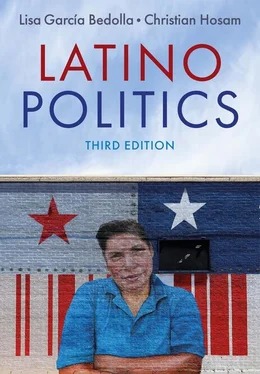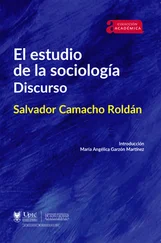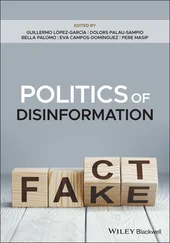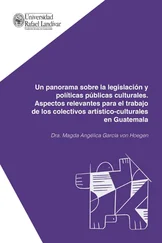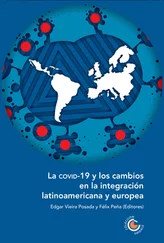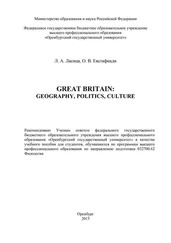When Latinos became part of the United States, either through immigration or through conquest (as in the case of Puerto Ricans, or of Mexican Americans in the nineteenth-century southwest), they were inserted into an established racial order. Even though many Latinos are recent immigrants, it is important to realize that this historical racial hierarchy continues to influence the playing field upon which their community sits today. For example, one complication for Latinos was that one-drop rules presupposed a strict, biological understanding of what race is. Under those regimes, a person was Black, white, or Indian, and there was no legal representation for intermediate categories like mulattos (people of combined Black and white ancestry). Latinos, on the other hand, come from a variety of ethnoracial backgrounds. When the Spaniards arrived in Latin America, that continent had an indigenous population which numbered millions of inhabitants. Although a large proportion of this native population perished through disease and wars of conquest, a significant part survived, particularly in Mexico, Central America, Colombia, Perú, and Bolívia. The Spanish mixed with these groups, as did enslaved Africans, creating what are called mestizos – individuals of mixed European, African, and indigenous descent. In the Caribbean, little of the indigenous population remained, which made it necessary for Spaniards to import enslaved Africans to use as the bulk of the labor force. Those Africans mixed with the Spaniards and with the indigenous groups who remained on the islands, creating a new racial admixture; this is often called mulatto. After the end of slavery, Caribbean plantation-owners imported hundreds of thousands of Chinese laborers to work in the fields. In the nineteenth and twentieth centuries, large numbers of Asians from other countries, including Japan, settled in other parts of Latin America, adding to its racial admixture. This is why, in the early twentieth century, José Vasconcelos called Latin Americans la raza cósmica (the cosmic race) – one made up of the blood of all the world’s races.
During the colonial period, the Spaniards developed a complex casta system, which laid out the racial hierarchy according to how much European, Black, or indigenous blood a particular individual had. Like the American system, the Spanish system placed the white Europeans on top; but the remainder included many more racial options than were available in the United States at that time. Most Latin American countries abolished the Spanish casta system after independence. But they still maintained the racial hierarchies. The difference was that their understanding of race included mixed race as a possibility, which was not true in most parts of the United States after the late nineteenth century. 16Thus, when Latinos arrived in the United States, they had to fit into a relatively rigid racial hierarchy, where it was very important whether a person was defined as “Black” or “white.” Yet many Latinos are of mixed race. Those of Mexican or Central American origin tend to be of mixed indigenous background, and those from the Caribbean are more likely to have African origins. But are they “Indian”? Or are they “Black”? Or something else? The problem with people of mixed race is that often there can be significant differences in skin color even within the same family. One sibling can be quite dark-skinned, another one quite light-skinned. Since the US racial structure did not allow for the possibility of admixture, what often happened was that the lighter-skinned sibling would be treated as “white,” the darker as “Black.” At the height of segregation, this meant that they could go to separate schools, get to use separate bathroom facilities, and in general would have a very different set of opportunities, simply because one was seen as white and the other was not. Latinos, then, complicated the US racial structure and did not fit neatly into any of its racial categories. This racial ambiguity meant that the location they chose to settle in, and the particular racial history in that place, had an important impact on the kinds of opportunities open to them. There was no one uniform response to, or treatment of, Latinos as a “race.”
For example, there were large numbers of Latinos, mostly of Mexican origin, living in the state of Texas during the nineteenth century. Many had been there originally when Texas was part of Mexico. Texas turned into a slave state once it became part of the United States, and after emancipation it developed and enforced strict Jim Crow laws, requiring racial segregation in neighborhoods, schools, and public facilities. Like the rest of the south, Texas also passed laws to keep Blacks from voting. Yet, in Texas, African Americans were not the only large minority group; there were Mexican Americans as well. Jim Crow laws were applied to the Mexican population because they too were seen as non-white, despite their legal categorization as white under the Treaty of Guadalupe Hidalgo. This was not true in New Mexico, however, where Latinos of Mexican origin remained in the majority until the twentieth century: in New Mexico, segregation was not as extreme as in Texas. Mexican Americans were allowed voting rights there. Moreover, they held public-office positions and much of the political power until the mid twentieth century. Thus, local context had an important impact on racial definitions and racial restrictions, even in the case of the same national-origin group. These differences were possible because of Latino racial ambiguity.
Thus, race is not “real” in a biological sense, but racial categories still have important implications for the opportunities which various groups have in our society. Without an understanding of the historical legacy of race, it is difficult to understand the current distribution of resources and opportunities within American society. Being white gave individuals access to citizenship; access to land under the Homestead Act in the nineteenth century (which was restricted to whites); access to legal protection and the right to organize unions, which significantly increased unionized workers’ wages and benefits (many unions prohibited non-white membership, and many people of color worked in industries not covered under the National Labor Relations Act); access to subsidized federal home loans (the Federal Housing Administration [FHA] program redlined and excluded African American, Mexican American, and mixed-race neighborhoods); and access to public education of adequate quality. 17Recent studies have shown that whites and African Americans with similar levels of income and education still have very different levels of total wealth because whites are much more likely to inherit real estate and other funds from their parents. 18That inheritance is the fruit of a highly exclusionary racial history. Because of this history, “color-blindness” will not erase the inequality which has accumulated from racial categorizations. It is only by looking at race that we can begin to address its negative legacy.
Gender: Latino Politics and Intersectionality
Gender 19identity also interacts with ethnoracial categories in ways that affect Latino incorporation patterns. Appreciating intersectionality – the idea that human beings possess multiple identifications simultaneously, and that the intersection of those identities has important implications for their beliefs, attitudes, and experiences – is important for understanding Latino political engagement. Studies have shown that female- and male-identified Latinos migrate for different reasons, and that cisgender women now make up a growing proportion of Latino migration streams. In the early twentieth century, Latin-American-origin migration was quite male-dominated; by the early twenty-first century, that trend had shifted, with growing numbers of Latin-American-origin women choosing to migrate to the United States. Gender ratios among the foreign-born vary in important ways by national origin and by legal status. 20The majority of Dominican migrants, for example, are female-identified, while there are more male-identified than female-identified Mexican migrants. Unauthorized migration flows, in addition, tend to be heavily male-identified, and more than three-quarters of the United States’ unauthorized migrants come from Mexico and Central America. These gender differences have their roots in social and economic forces within the home countries, and have an effect on immigrants’ integration experiences in the United States.
Читать дальше
